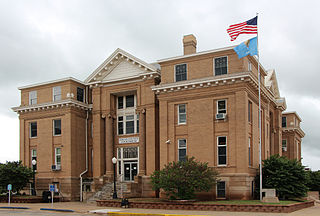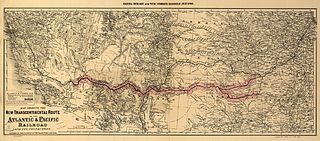
Logan County is a county located in the U.S. state of Oklahoma. As of the 2020 census, the population was 49,555. Its county seat is Guthrie.

Kiowa is a city in Barber County, Kansas, United States. As of the 2020 census, the population of the city was 902. It is located 1 mile north of the Kansas / Oklahoma state border.

Fairmont is a town in Garfield County, Oklahoma, United States. The population was 134 at the 2010 census, a decrease from 147 at the 2000 census.

BNSF Railway is the largest freight railroad in the United States. One of six North American Class I railroads, BNSF has 35,000 employees, 32,500 miles (52,300 km) of track in 28 states, and nearly 8,000 locomotives. It has three transcontinental routes that provide rail connections between the western and eastern United States. BNSF trains traveled over 169 million miles in 2010, more than any other North American railroad.

The Atchison, Topeka and Santa Fe Railway, often referred to as the Santa Fe or AT&SF, was one of the larger railroads in the United States. The railroad was chartered in February 1859 to serve the cities of Atchison and Topeka, Kansas, and Santa Fe, New Mexico. The railroad reached the Kansas–Colorado border in 1873 and Pueblo, Colorado, in 1876. To create a demand for its services, the railroad set up real estate offices and sold farmland from the land grants that it was awarded by Congress.

The Midland Railway was a heritage railroad operating 16 miles of line in Franklin and Douglas counties, Kansas between Ottawa, Kansas and Baldwin City, Kansas.

Railroad Wars were business rivalries between railroad companies, which occurred frequently in American history. Although they were usually little more than legal disputes inside a courtroom, they sometimes turned into armed conflicts. There has been competition between railroad companies since the beginning of railroading in the United States, but violent confrontations were most common in the final quarter of the 19th century, particularly in the Old West.

The Atlantic and Pacific Railroad was a U.S. railroad that owned or operated two disjointed segments, one connecting St. Louis, Missouri with Tulsa, Oklahoma, and the other connecting Albuquerque, New Mexico with Needles in Southern California. It was incorporated by the U.S. Congress in 1866 as a transcontinental railroad connecting Springfield, Missouri and Van Buren, Arkansas with California. The central portion was never constructed, and the two halves later became parts of the St. Louis-San Francisco Railway and Atchison, Topeka and Santa Fe Railway systems, now both merged into the BNSF Railway.

The Panhandle and Santa Fe Railway (P&SF) is a now-defunct railroad company that was a subsidiary of the Atchison, Topeka and Santa Fe Railway (AT&SF), operating primarily in the Texas Panhandle.

K-8 is the name of two separate state highways in Kansas, United States. The southern highway is a 1.275-mile-long (2.052 km) road, linking Oklahoma State Highway 8 (SH-8) to the town of Kiowa. The northern highway is a 15.979-mile-long (25.716 km) road, linking U.S. Route 36 (US-36) near Athol to Nebraska Highway 10 (N-10) near the town of Franklin.
The Arkansas Valley and Western Railway (AV&W) was built as a short line railroad operating within the U.S. state of Oklahoma. It was founded in 1902 to link the city of Tulsa with the main transcontinental line of the Atchison, Topeka and Santa Fe Railway (AT&SF) at Avard. The line was built in sections, initially from AV&W Jct. to Steen (Enid) during 1902-03. In 1904 it was extended westward to the junction with AT&SF at Avard. On July 19, 1907, the railroad was purchased by the St. Louis-San Francisco Railway, who operated it until November 21, 1980, when the Frisco was acquired by Burlington Northern Railroad.

Blanton is an unincorporated community in Garfield County, Oklahoma, United States. It was a rail stop for two rail lines, one of which used to transport grain until the mid-1990s. It was named after Denver, Enid and Gulf Railroad (DE&G) executive W. B. Blanton.

The Southern Transcon is a main line of BNSF Railway comprising 11 subdivisions between Southern California and Chicago, Illinois. Completed in its current alignment in 1908 by the Atchison, Topeka and Santa Fe Railway, when it opened the Belen Cutoff in New Mexico and bypassed the steep grades of Raton Pass, it now serves as a mostly double-tracked intermodal corridor.
The V&S Railway is a shortline railroad that operates two disconnected lines in the U.S. state of Kansas. It is affiliated with A&K Railroad Materials. The company acquired its first line, a former Atchison, Topeka and Santa Fe Railway line between Medicine Lodge and a BNSF Railway junction at Attica, from the Central Kansas Railway in 2000. In 2006 it expanded its operations by acquiring from the Hutchinson and Northern Railway a short segment of former interurban in eastern Hutchinson, where it interchanges with the BNSF Railway, Union Pacific Railroad, and Kansas and Oklahoma Railroad. Other railroads under common control with the V&S are the out-of-service Kern Valley Railroad in Colorado, the Gloster Southern Railroad in Louisiana and Mississippi, the Grenada Railway and Natchez Railway in Mississippi, a portion of the former Rock Island from St. Louis to Union, Missouri operated by the Missouri Central and the Southern Manitoba Railway in Manitoba.

The Railroad Museum of Oklahoma is a railroad museum located in the former Atchison, Topeka and Santa Fe Railway freight depot in Enid, Oklahoma. The museum began in 1977 and is a non-profit operated by the Enid chapter of the National Railway Historical Society. The freight depot was listed on the National Register of Historic Places in 2015.

The Cane Belt Railroad was chartered in the U.S. state of Texas in 1898. Formed by a group of businessmen from Eagle Lake, the short-line railroad was intended to bring the area's sugarcane to market. In 1902 a disagreement between two of the railroad's chief promoters proved deadly. By 1904 the line was in operation from Sealy to Matagorda on the Gulf of Mexico. That year the company's stock was bought by the Atchison, Topeka and Santa Fe Railway and the line continued operations under lease to the Gulf, Colorado and Santa Fe Railway starting in 1905. By the 1920s, the local sugarcane industry collapsed but the railroad was saved by the discovery of two nearby sulphur mines. In 1948, the Cane Belt was merged into the Gulf, Colorado and Santa Fe Railway. In the 1990s most of the original line was abandoned after the last sulphur mine closed. By 2013, only a small portion of the line south of Bay City was operating as part of the BNSF Railway.
The BNSF Avard Subdivision runs 177 miles (285 km) of track between Tulsa, Oklahoma, starting at milepost (MP) 425.2, to Avard, Oklahoma, MP 602, where it meets the BNSF Panhandle Sub.
The Eastern Oklahoma Railway was incorporated under the laws of Oklahoma Territory on July 24, 1899. The railroad constructed much of its own track. This included Guthrie junction to Cushing junction, 47.9 miles, in the 1900-1902 timeframe; Ripley to Esau Junction, 40.4 miles, also in the 1900-1902 timeframe; Newkirk to Pauls Valley, 182.5 miles, in the 1900-1904 timeframe; and, Davis to Sulphur, 9.3 miles, in 1906.
The Kiowa, Chickasha and Fort Smith Railway (KC&FS) came about when the Atchison, Topeka and Santa Fe Railway (AT&SF) and the Chicago, Rock Island and Pacific Railroad decided to build an interchange linking their systems at a point halfway between the towns of Chickasha and Pauls Valley in what is now the State of Oklahoma. Toward that goal, the AT&SF incorporated The Kiowa, Chickasha and Fort Smith Railway Company in Kansas on July 13, 1899, which then built a line from Pauls Valley to what became the town of Lindsay, a distance of 24.2 miles, in the 1901-1903 timeframe. The line’s first operation was in December of 1903.
















